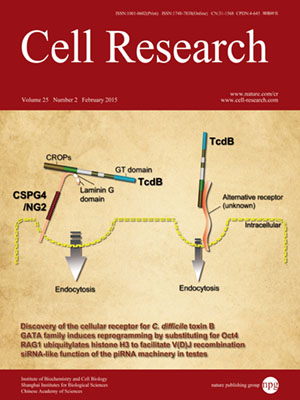
Volume 25, No 2, Feb 2015
ISSN: 1001-0602
EISSN: 1748-7838 2018
impact factor 17.848*
(Clarivate Analytics, 2019)
Volume 25 Issue 2, February 2015: 258-261
LETTERS TO THE EDITOR
One-step generation of p53 gene biallelic mutant Cynomolgus monkey via the CRISPR/Cas system
Haifeng Wan1,*, Chunjing Feng1,2,*, Fei Teng1,2,*, Shihua Yang3,4,*, Baoyang Hu1, Yuyu Niu5, Andy Peng Xiang6, Weizhen Fang7, Weizhi Ji5, Wei Li1, Xiaoyang Zhao1 and Qi Zhou1
1State Key Laboratory of Reproductive Biology, Institute of Zoology, Chinese Academy of Sciences, Beijing 100101, China
2University of Chinese Academy of Sciences, Beijing 100049, China
3College of Veterinary Medicine, South China Agricultural University, Guangzhou, Guangdong 510642, China
4Key Laboratory of Comprehensive Prevention and Control for Severe Clinical Animal Diseases of Guangdong Province, Guangzhou, Guangdong 510642, China
5Yunnan Key Laboratory of Primate Biomedical Research, Kunming, Yunnan 650500, China
6Center for Stem Cell Biology and Tissue Engineering, Key Laboratory for Stem Cells and Tissue Engineering, Sun Yat-Sen University, Guangzhou, Guangdong 510080, China
7Beijing Xieerxin Institute of Biological Resources, Beijing, China
Correspondence: Qi Zhou, E-mail: qzhou@ioz.ac.cn; Xiaoyang Zhao, E-mail: xyzhao@ioz.ac.cn; Wei Li,(liwei@ioz.ac.cn)
Non-human primates (NHPs) are genetically, physiologically and psychologically more similar to humans than other model organisms, providing an important model for human development and diseases1,2. Precise genome modification in non-human primates (NHPs) holds great promise for biomedical researches. However, owing to the long sexual maturation time and low reproduction rate of NHPs, it is very challenging to generate biallelic mutant NHPs for loss-of-function studies through breeding. Recently, the site-specific nucleases, namely TALENs (transcription activator-like effector nucleases) and CRISPR (clustered regularly interspaced short palindromic repeat)/Cas (CRISPR-associated) system, make it feasible to generate NHPs with precise genome modifications, yet the resulting transgenic animals exhibited mosaic mutations accompanied by the presence of wild type allele in different tissues3,4. Thus, the feasibility of obtaining biallelic mutations in monkeys remains an open question. Here we report that by systematically optimizing the mutagenesis efficiency of the CRISPR/Cas-based method in monkeys, we have successfully obtained the first live p53 biallelic mutant monkey, and achieved homology directed repair (HDR)-driven gene editing with nucleotide-level precision in monkey embryos.
10.1038/cr.2014.158
FULL TEXT | PDF
Browse 2533


